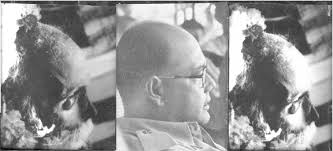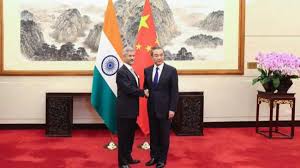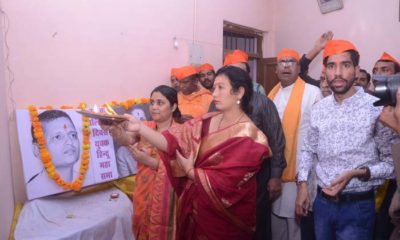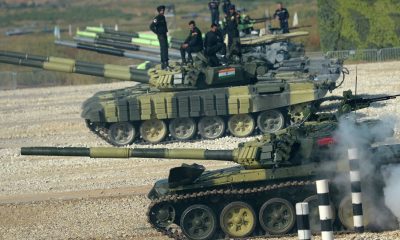Feature
Death of Netaji Subhas Chandra Bose ,75-year-old mystery from Russian angle.

The mystery of what happened to Netaji Subhas Chandra Bose and how did he die continues to persist, even 75 years after he supposedly perished in an air crash in Taipei. Even though Justice MK Mukherjee, who was the one-man commission to inquire about the ultimate fate of Netaji, reported (in 2005) that he did not die in the so-called air crash, the commission could not conclude about his ultimate fate.
Lately Netaji’s grand-nephew Surya Kumar Bose and grand-niece Madhuri Bose have raised an objection to Justice Mukherjee’s report and vociferously declared that Netaji had perished in the air crash. The declaration comes even as Bengali commercial movies on Gumnami Baba hit the screen last year. Gumnami Baba, a so-called holy man lived in Faizabad (the twin city of Ayodhya) from the 1960s onward till 1987 when he died. Gumnami Baba lived in isolation and he had a handful of disciples who believed that he was Netaji living incognito.
At that time there were rumours that Netaji was in hiding in the USSR. It was feared that he could land in India and his presence would destabilise the political set-up in the country. Gumnami and other babas would in that case stand up and make their own claims to confuse matters. Gumnami Baba proved to be the most everlasting of all the holy man set-up. Others like Shaulmari baba who lived in an ashram close to Farakka, was discovered to be a displaced person from Dhaka.
Iqbal Chand Malhotra, a documentary filmmaker and researcher from Delhi is of the firm belief that with the Second World War ending in favour of the Allied Forces, Netaji made his escape. He did not escape from Saigon on board a Japanese bomber that is supposed to have crashed in Taipei (which is the general belief among those who believe that Netaji survived) but on a German submarine from Singapore that carried him to Vladivostok.
From here, Subhas Bose made his way to inland USSR. The submarine, which contained gold and precious stones, then sailed to Tokyo. According to Malhotra, the submarine was part of the ‘Monsun grupe’ that was deployed in south-east Asia courtesy the Germans.
The 33rd flotilla was based in Penang and had 34 German U boats and 7 Italian transport submarines. But it continued operations even after the Germans surrendered in May 1945. The gold and precious stones had been picked up from Penang in Malaysia which had fallen to the Japanese. They had been processed at a refinery and much of it comprised donations by Indians to fight the British.
What happened to Netaji after he disembarked at Vladivostok cannot be said with precision. However, Purabi Roy, an Indian researcher who spent long years in Russia, came to know about a document in the archives of GRU (an intelligence agency) in Padolsk near Moscow that refers to a meeting between Joseph Stalin and his three aides (Vyacheslav Molotov, Andrey Vyschinsky and Yakov Malik) in October 1946 where they were discussing ‘where to keep Chandra Bose.’
The document was seen by Major General Aleksander Kolesnikov who had been befriended by Roy and sent to the archive. The archive is only accessible to Russian citizens and therefore Roy (although she knows Russian) could not go in.
In 1998, when the MK Mukherjee inquiry commission on Netaji went to Moscow to record evidence, Kolesnikov then serving in Istanbul and did not appear before it. Therefore his findings shared with Purabi Roy could not be taken cognizance of.
However, two decades later in 2016, Kolesnikov appeared in a documentary produced by the aforementioned Iqbal Malhotra where he mentioned about the document he found in GRU archives where Stalin and his aides were discussing on what to do with Bose. This lead has however not been seriously pursued by the Indian government.
Incidentally, when documents relating to Netaji were declassified in 2016, a file tumbled out which showed that Subhas Bose had broadcast three times from overseas between December 26, 1945, and February 1946. The broadcasts were caught by an IB station in Governor’s House Calcutta and Netaji promised that he would come back and that freedom was close at hand.
But Netaji never turned up and no confirmed information surfaced about him again. But the declassified files had a note addressed by the Viceroy of India to the British PM asking about the policy about Bose. On October 25, 1945, the British PM convened a meeting where it was decided to allow Subhas Bose to ‘remain where he was.’
Speculation is that Stalin may have kept Netaji alive as a force which could be deployed against Nehru and other leaders who he considered as British agents. But Stalin died in 1953 and the new leaders of the Soviet Union having made up with Nehru dispatched Netaji to Siberia, per the rumours.
Entertainment
Meghalaya Reserves Legalized Gambling and Sports Betting for Tourists

The State Scores Extra High on Gaming-Friendly Industry Index
Meghalaya scored 92.85 out of 100 possible points in a Gaming Industry Index and proved to be India’s most gaming-friendly state following its recent profound legislation changes over the field allowing land-based and online gaming, including games of chance, under a licensing regime.
The index by the UK India Business Council (UKIBC) uses a scale of 0 to 100 to measure the level of legalisation on gambling and betting achieved by a state based on the scores over a set of seven different games – lottery, horse racing, betting on sports, poker, rummy, casino and fantasy sports
Starting from February last year, Meghalaya became the third state in India’s northeast to legalise gambling and betting after Sikkim and Nagaland. After consultations with the UKIBC, the state proceeded with the adoption of the Meghalaya Regulation of Gaming Act, 2021 and the nullification of the Meghalaya Prevention of Gambling Act, 1970. Subsequently in December, the Meghalaya Regulation of Gaming Rules, 2021 were notified and came into force.
All for the Tourists
The move to legalise and license various forms of offline and online betting and gambling in Meghalaya is aimed at boosting tourism and creating jobs, and altogether raising taxation revenues for the northeastern state. At the same time, the opportunities to bet and gamble legally will be reserved only for tourists and visitors.
“We came out with a Gaming Act and subsequently framed the Regulation of Gaming Rules, 2021. The government will accordingly issue licenses to operate games of skill and chance, both online and offline,” said James P. K. Sangma, Meghalaya State Law and Taxation Minister speaking in the capital city of Shillong. “But the legalized gambling and gaming will only be for tourists and not residents of Meghalaya,” he continued.
To be allowed to play, tourists and people visiting the state for work or business purposes will have to prove their non-resident status by presenting appropriate documents, in a process similar to a bank KYC (Know Your Customer) procedure.
Meghalaya Reaches Out to a Vast Market
With 140 millions of people in India estimated to bet regularly on sports, and a total of 370 million desi bettors around prominent sporting events, as per data from one of the latest reports by Esse N Videri, Meghalaya is set to reach out and take a piece of a vast market.
Estimates on the financial value of India’s sports betting market, combined across all types of offline channels and online sports and cricket predictions and betting platforms, speak about amounts between $130 and $150 billion (roughly between ₹9.7 and ₹11.5 lakh crore).
Andhra Pradesh, Telangana and Delhi are shown to deliver the highest number of bettors and Meghalaya can count on substantial tourists flow from their betting circles. The sports betting communities of Karnataka, Maharashtra, Uttar Pradesh and Haryana are also not to be underestimated.
Among the sports, cricket is most popular, registering 68 percent of the total bet count analyzed by Esse N Videri. Football takes second position with 11 percent of the bets, followed by betting on FIFA at 7 percent and on eCricket at 5 percent. The last position in the Top 5 of popular sports for betting in India is taken by tennis with 3 percent of the bet count.
Local Citizens will Still have Their Teer Betting
Meghalaya residents will still be permitted to participate in teer betting over arrow-shooting results. Teer is a traditional method of gambling, somewhat similar to a lottery draw, and held under the rules of the Meghalaya Regulation of the Game of Arrow Shooting and the Sale of Teer Tickets Act, 2018.
Teer includes bettors wagering on the number of arrows that reach the target which is placed about 50 meters away from a team of 20 archers positioned in a semicircle.
The archers shoot volleys of arrows at the target for ten minutes, and players place their bets choosing a number between 0 and 99 trying to guess the last two digits of the number of arrows that successfully pierce the target.
If, for example, the number of hits is 256, anyone who has bet on 56 wins an amount eight times bigger than their wager.























